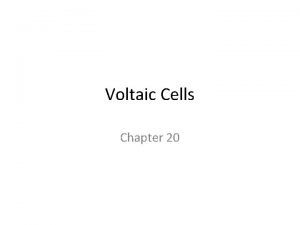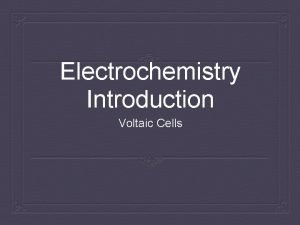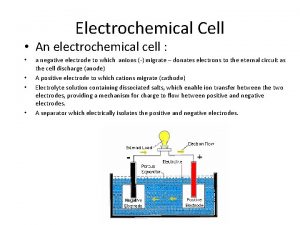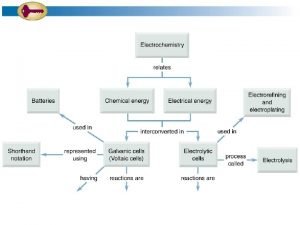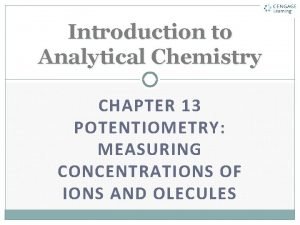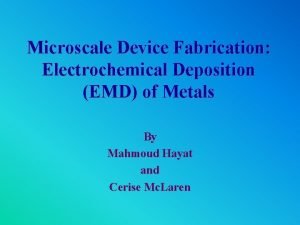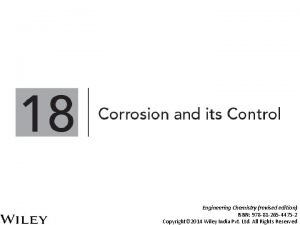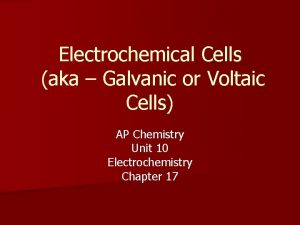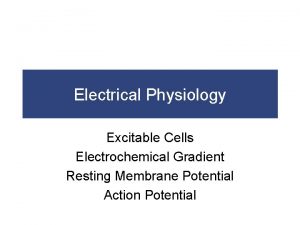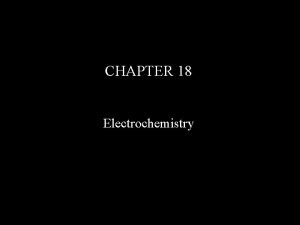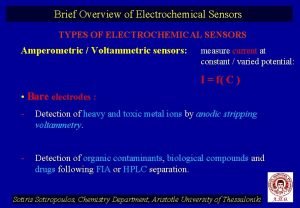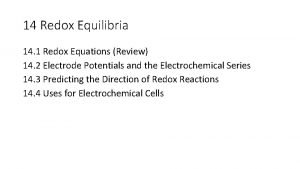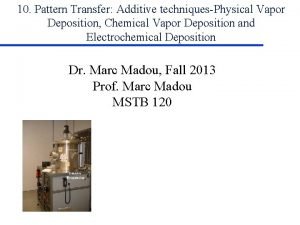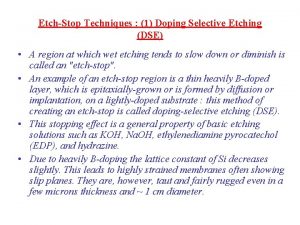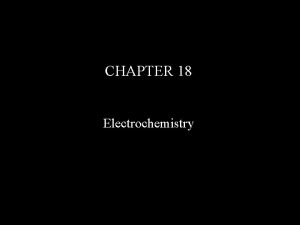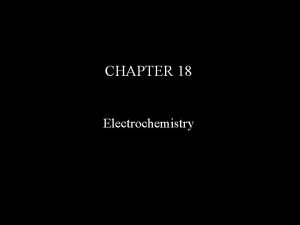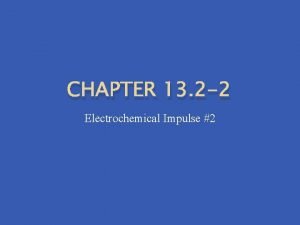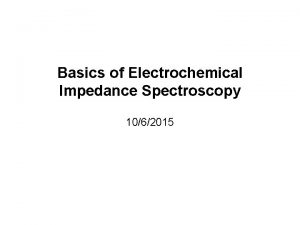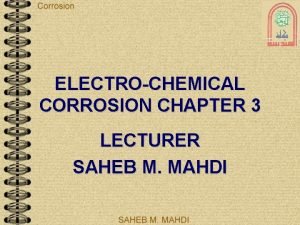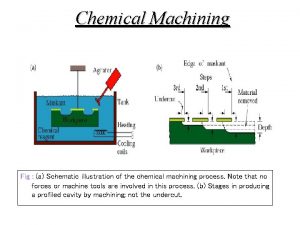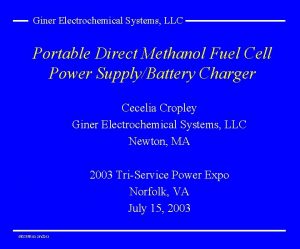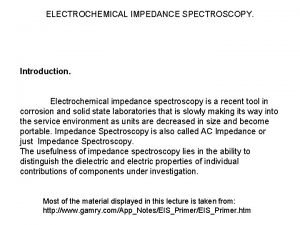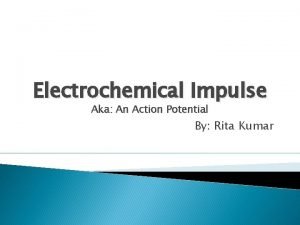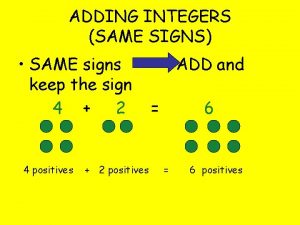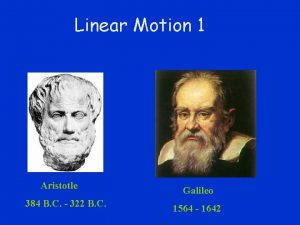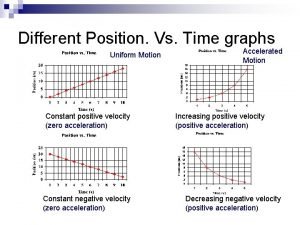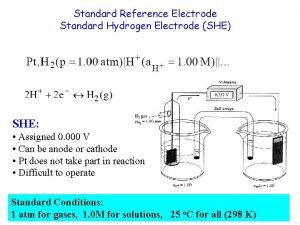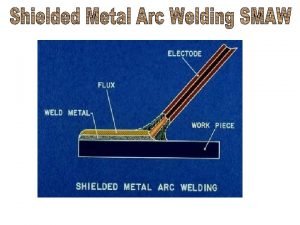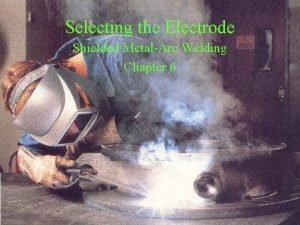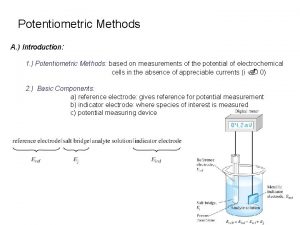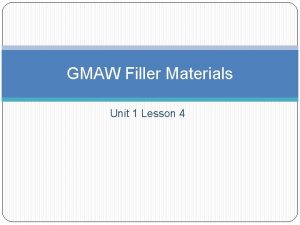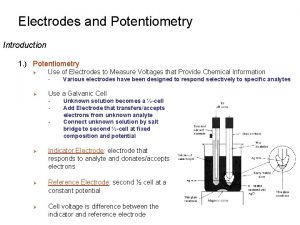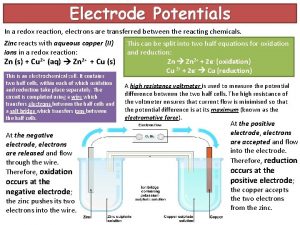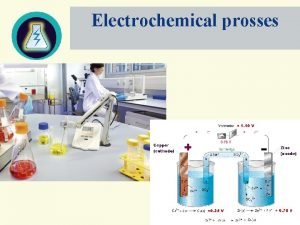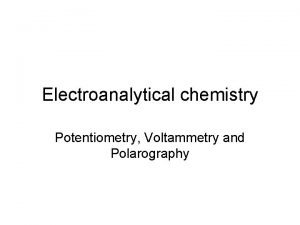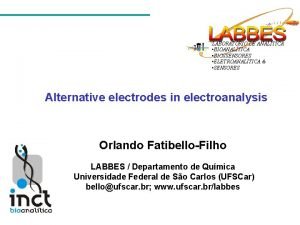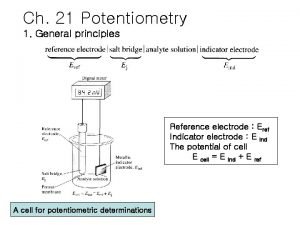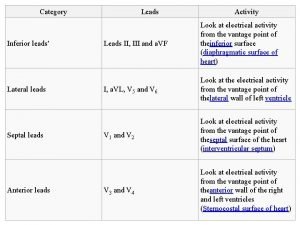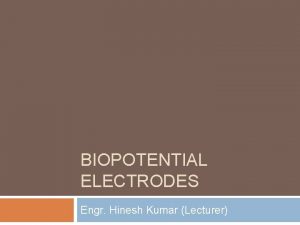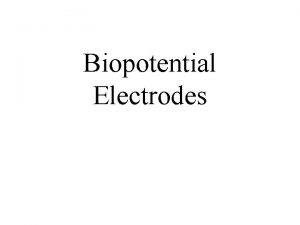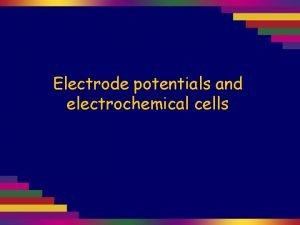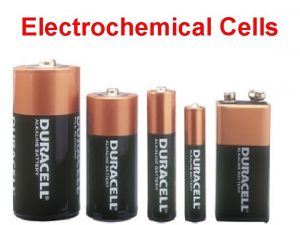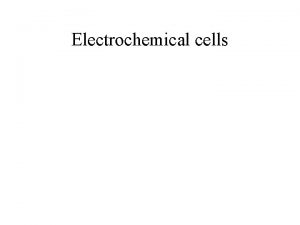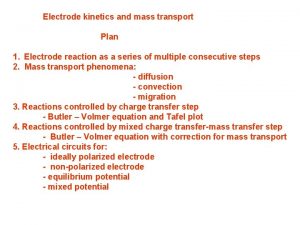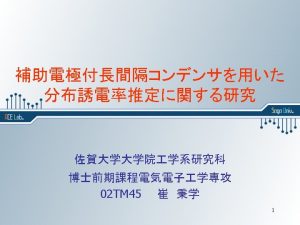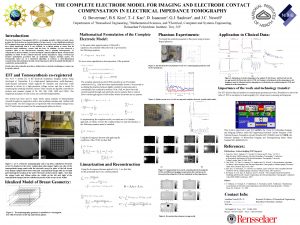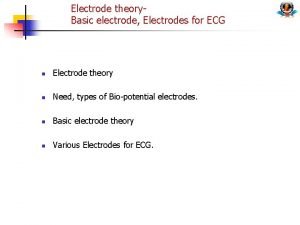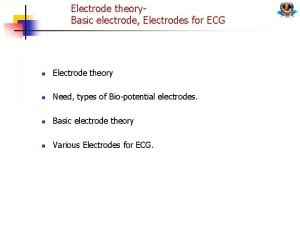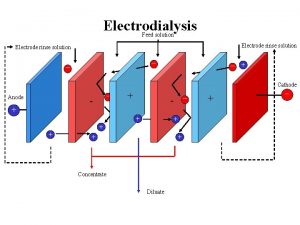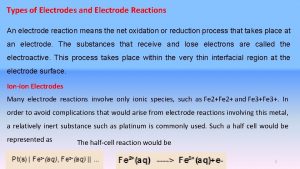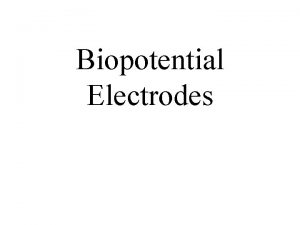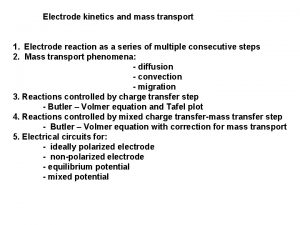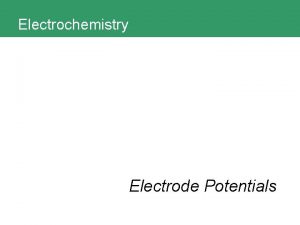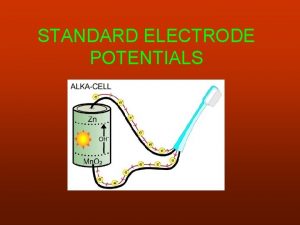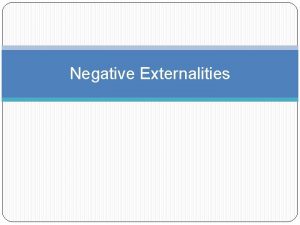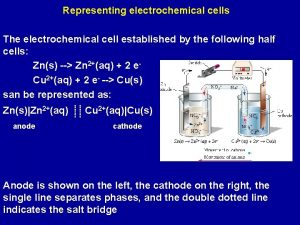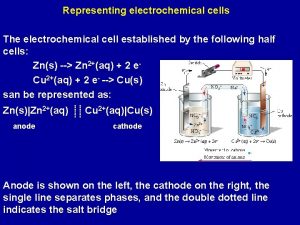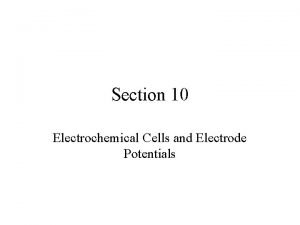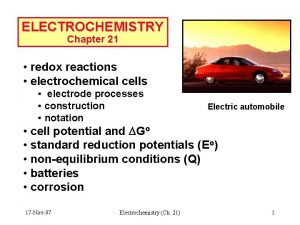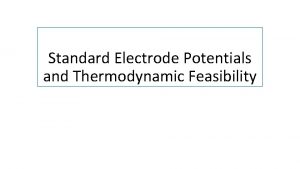Electrochemical Cell An electrochemical cell a negative electrode
























































- Slides: 56

Electrochemical Cell • An electrochemical cell : • • a negative electrode to which anions (-) migrate – donates electrons to the eternal circuit as the cell discharge (anode) A positive electrode to which cations migrate (cathode) Electrolyte solution containing dissociated salts, which enable ion transfer between the two electrodes, providing a mechanism for charge to flow between positive and negative electrodes. A separator which electrically isolates the positive and negative electrodes.

How Electrochemical Batteries Work • REDOX Reaction Electron Flow → Anode Salt Bridge + --++ Cathode Oxidation, the loss of electrons, occurs at the anode. Electrolyte Reduction, the gain of electrons, occurs at the cathode.

The Periodic Table: choose the electrode Combination of electrodes to make a variety types of batteries: lithium ion battery、nickel-zinc、zinc air、Nickel cadmium、Ni iron、Silver zinc、Mercury cell

The History of Battery Volta piles Baghdad battery Lithium ion battery -sony

Electrochemical Battery History Cont’d • The Voltaic Pile – Invented by Alessandro Volta in 1800 – Zinc and Copper with a cloth soaked in brine – Technical Flaws: • Compressing of cloth created shorts • Short battery life • The Daniel Cell – Invented in 1836 by John Daniell • The lead-acid cell – Invented in 1859 by Gaston Planté – First rechargeable battery • The zinc-carbon cell – Invented in 1887 by Carl Gassner

Electrochemical Battery History Cont’d • The Nickel-Cadmium Battery – Invented in 1899 by Waldmar Jungner. • The common Alkaline Battery – Invented in 1955 by Lewis Urry • The Nickel Metal-Hydrid Battery – Ni. MH batteries for smaller applications started to be on the market in 1989. • Lithium and Lithium-ion Batteries – First lithium batteries sold in the 1970 s – First lithium-ion batteries sold in 1991 portable electronic devices – First lithium-ion polymer batteries released in 1996


Various kinds of batteries

Primary vs. Secondary Batteries • Primary batteries are disposable:their electrochemical reaction cannot be reversed. • Secondary batteries are rechargeable, because their electrochemical reaction can be reversed by applying a certain voltage to the battery in the opposite direction of the discharge.


Terminology and Units Primary Batteries – Disposable Secondary Batteries – Rechargeable emf – Electromotive force, voltage Ampere∙hour (Ah) = 3600 coulombs, a measure of electric charge • Watt ∙hour (Wh) = 3600 joules, a measure of energy • Ah = (Wh) / emf • •

Theoretical Cell voltage • Anode (oxidation potential)+ cathode (reduction potential)=standard cell potential Zn+Cl 2 Zn Zn+2 +2 e Cl 2 2 Cl- -2 e Eo -(-0. 76 V) 1. 36 V = 2. 12 V theoretical voltage

Theoretical capacity • Zn 0. 82 Ah/g 1. 22 g/Ah + Cl 2 Zn. Cl 2 0. 76 Ah/g 1. 32 g/Ah = 2. 54 g. AH or 0. 394/Ah/g

Primary Alkaline Batteries • Can lose 8 – 20% charge every year at room tempurature. • Discharge performance drops at low temperatures. AAA AA 9 V C D Capacity (Ah) 1. 250 2. 890 0. 625 8. 350 20. 500 Voltage 1. 5 9 1. 5 Energy (Wh) 1. 875 4. 275 5. 625 12. 525 30. 75

Secondary Alkaline Batteries • Self-discharge more quickly than primary batteries Low-Capacity Ni. MH (1700 -2000 m. Ah) Charge Cycles 1000 High-Capacity Ni. MH (2500+ m. Ah) 500 Ni. Cd 1000 • Must not overcharge because that will damage the batteries. Quick charges will also damage the batteries. • Must not over-discharge. • Ni. Cd has “memory effect. ” • Ni. Cd is better for applications where current draw is less than the battery’s own self-discharge rate. • Ni. MH have a higher capacity, are cheaper, and are less toxic than Ni. Cd.

Recharge-ability & the “memory effect” • Recharge-ability: basically, when the direction of electron discharge (negative to positive) is reversed, restoring power. • the Memory Effect: Effect - The battery appears to "remember" the smaller capacity - the term 'memory' came from an aerospace nickel-cadmium application in which the cells were repeatedly discharged to 25% of available capacity by exacting computer control, then recharged to 100% capacity without overcharge. This long-term, repetitive cycle regime, with no provision for overcharge, resulted in a loss of capacity beyond the 25% discharge point. Hence the birth of a "memory" phenomenon, whereby nickel-cadmium batteries purportedly lose capacity if repeatedly discharged to a specific level of capacity. Source: wiki

Types of Batteries • Zinc-Carbon: used in all inexpensive AA, C, and D dry-cell batteries. The electrodes are zinc and carbon, with an acidic paste between them serve as the electrolyte (disposable) • Alkaline: Curalcell or Energizer cell batteries. The electrodes are zinc and manganese-oxide, with an alkaline electrolyte (disposable)

Modern batteries • Lead-Acid: used in cars: the electrodes are lead and lead-oxide, with an acidic electrolyte (rechargeable) • Lithium-ion batteries - rechargeable and no memory effect • Fuel cells


Battery Aspects • Energy Density: total amount of energy that can be stored per unit mass or volume how long will your laptop run by a fully-charged cell. • Power Density: Maximum rate of energy discharge per unit mas or volume. Low power: laptop, ipod high power car • Safety: could sustain at high temperatures • Life: stability of energy density and power density with repeated cycling is needed for the long life required in many applications. • Cost: Must compete with other energy storage technologies

Lithium ion battery

Lithium • Periodic Table Symbol: Li • Atomic Weight: 3 (light!) • Like sodium and potassium, an alkali metal. (Group 1 – #s 1 through 7) • Highly reactive, with a high energy density. • Used to treat manic-depression because it is particularly effective at calming a person in a “manic” state. • The most electropositive (-3. 04 V versus standard hydrogen electrode


Composition of Li-ion batteries

Lithium Ion Battery Development • Pioneering work for the lithium battery bagan in 1912 by G. N. Lewis but it was not until the early 1970’s when the first non-rechargeable lithium batteries became commercially availble • In the 1970’s Lithium metal was used but its instability rendered it unsafe


Lithium Ion Battery Development • Attempts to develop recharageable lithium batteries followed in the eithties, but failed due to safty problems • The lithium ion battery has a slightly lower energy density than lithium metal, but it is much safer. Introduced by Sony 1991

Lithium secondary battery • A chemical intercalation reaction • Intercalation is the reversible inclusion of a molecule between two other molecules Ex: graphite intercalation compounds Armand, Nature, 2001

The operation principle of a Li-Ion battery


Overall reaction of Li-ion battery P. G. Bruce, B. Scrosati, J. M. Tarascon, Angew Chem. Int. Ed. , 2008, 47, 2930 ΔV Charging Co+3 ->Co+4 discharging Co+4 ->Co+3

Rocking-chair tecnology

Combination of positive materials and negative materials for Lithium batteries Armand, Nature, 2001

Voltage of a cell

Capacity

Cathode materials

Cathode materials in Lithium-ion batteries



Cathode Materials Challenges • The most desirable cathode materials are strong oxiding agents that can react with and decompose organic electrolytes • In extreme cases, problems with internal shorts or improper voltages can trigger exthermic reactions, leading to thermal runaway and catastropic falure

Anode materials: Carbon However, its theoretical capacity (Li. C 6) is only 372 m. Ahg -1

Anode materials


Li-alloy based anode materials for Li secondary batteries CSR, 2010

Anode capacity for total specific capacity Electro Acta



Electrolyte challenges: • Liquid electrolyte (Li. PF 6/EC+DMC) • Problems: leakage, non-flexibility of the cells, side reactions with charged electrodes • Explosions


Lithium-Ion and Lithium-Ion Polymer Batteries • Great energy-to-weight ratio (~160 Wh/kg compared to 30 -80 Wh/kg in Ni. MH) • No memory effect. • Slow self-discharge rate. • Battery will degrade from moment it is made. • Protection circuits are required to protect the battery. • Li-Ion Polymer batteries are significantly improved. – – Higher energy density. Lower manufacturing costs More robust to physical damage Can take on more shapes.

Comparison of the different battery technologies in terms of volumetric and gravimetric energy density. Armand, Nature, 2001


Disadvantages of Li-Ion EXPENSIVE -- 40% more than Ni. Cd. DELICATE -- battery temp must be monitored from within (which raises the price), and sealed particularly well. REGULATIONS -- when shipping Li-Ion batteries in bulk (which also raises the price). Class 9 miscellaneous hazardous material UN Manual of Tests and Criteria (III, 38. 3)

Schematic drawing of Li-ion batteries


 Cell reaction
Cell reaction Cell chapter 20
Cell chapter 20 Electrons flow from anode to cathode
Electrons flow from anode to cathode Cathode is the negative electrode
Cathode is the negative electrode Image of galvanic cell
Image of galvanic cell Calomel electrode
Calomel electrode Electrochemical deposition
Electrochemical deposition Electrochemical theory of corrosion
Electrochemical theory of corrosion Electrochemical machining animation
Electrochemical machining animation Action potential propagation
Action potential propagation Electrochemical series
Electrochemical series Types of electrochemical sensors
Types of electrochemical sensors Chloride half equation
Chloride half equation Diffusion limited
Diffusion limited Prevention of corrosion
Prevention of corrosion Dse
Dse What are electrochemical series
What are electrochemical series Electrochemical series order
Electrochemical series order Electrochemical impulse
Electrochemical impulse Impedance definition
Impedance definition Module 10 the nervous and endocrine systems
Module 10 the nervous and endocrine systems Types of electrochemical corrosion
Types of electrochemical corrosion Advantages of electrochemical machining
Advantages of electrochemical machining The stage that creates an “electrochemical gradient”. *
The stage that creates an “electrochemical gradient”. * How breathalyzer electrochemical
How breathalyzer electrochemical Electrochemical gradient
Electrochemical gradient Electrochemical gradient
Electrochemical gradient Giner electrochemical systems
Giner electrochemical systems Electrochemistry is
Electrochemistry is Electrochemical impedance spectroscopy
Electrochemical impedance spectroscopy Khancademy
Khancademy If the signs are the same
If the signs are the same Negative velocity negative acceleration
Negative velocity negative acceleration Uniform motion graphs
Uniform motion graphs She equation
She equation Shielded metal arc welding
Shielded metal arc welding Preventive maintenance of electrode holder
Preventive maintenance of electrode holder Cover pass welding definition
Cover pass welding definition Metallic indicator electrode
Metallic indicator electrode Dropping mercury electrode diagram
Dropping mercury electrode diagram Polarizable and non polarizable electrode
Polarizable and non polarizable electrode Mengelas
Mengelas Amperometry vs potentiometry
Amperometry vs potentiometry Gmaw electrode classification
Gmaw electrode classification Potentiometry introduction
Potentiometry introduction In a redox reaction, electrons are transferred
In a redox reaction, electrons are transferred Gibs
Gibs Dropping mercury electrode diagram
Dropping mercury electrode diagram Dropping mercury electrode diagram
Dropping mercury electrode diagram Types of defibrillator electrodes
Types of defibrillator electrodes Defibrillator
Defibrillator Arc
Arc Smaw electrode designation
Smaw electrode designation Principle of potentiometry
Principle of potentiometry Septal anterior lateral inferior
Septal anterior lateral inferior Hypodentie
Hypodentie Micropipette
Micropipette

